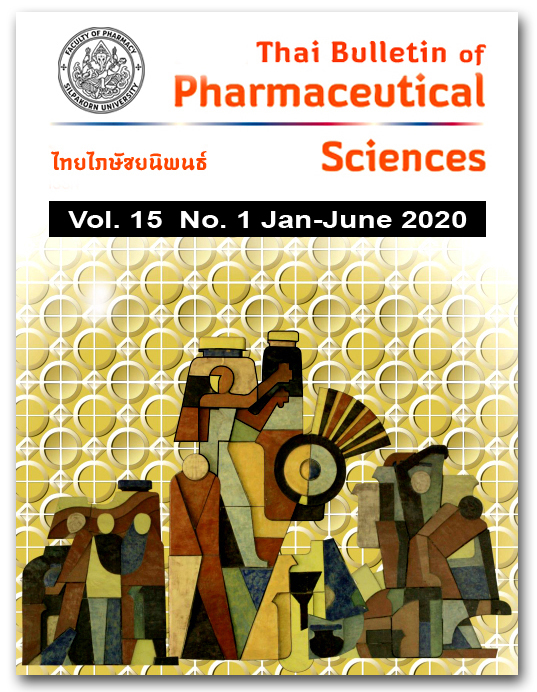SYNTHESIS AND ANTI-TYROSINASE ACTIVITY EVALUATION OF FLUORINATED CHALCONE AND PHENYL BENZYL ETHER DERIVATIVES
DOI:
https://doi.org/10.69598/tbps.15.1.81-89Keywords:
anti-tyrosinase activity, bibenzyl compounds, chalcone, phenyl benzyl ether, whitening agentAbstract
Pigmentation is a common skin disorder caused by several factors including UV exposure, skin aging, hormonal imbalance and skin irritation. Ascorbic acid, alpha-arbutin, tranexamic acid, kojic acid, and niacinamide have all been used in skin lightening treatments. This study aimed to develop a new active compound for skin lightening. Ten chalcone and nine phenyl benzyl ether analogues of bibenzyl compounds and bifluranol (9) were synthesized using aldol condensation reaction and Williamson ether synthesis, respectively. Their activity in vitro against tyrosinase, the rate-determining enzyme in melanogenesis, was evaluated at 500 µM. The results revealed that the chalcone analogues were more active than the phenyl benzyl ethers. The p-fluorinated analogues for both chalcone 12d (p-F) and ether 15d (p-F) inhibited tyrosinase in vitro to the highest extent for each series with inhibitory percentages of 38 and 32 at 500 µM respectively. These findings might provide useful guidance for further structural development of the more potent tyrosinase inhibitors used in whitening agents.
References
2. Brenner M, Hearing VJ. The protective role of melanin against UV damage in human skin. Photochem Photobiol. 2008;84:539-49.
3. Dogra S, Sarangal R. Pigmentary disorders: an insight. Pigment Int. 2014;1(1):5-7.
4. Park HY, Kosmadaki M, Yaar M, Gilchrest BA. Cellular mechanisms regulating human melanogenesis. Cell Mol Life Sci. 2009;66(9):1493-506.
5. Kilimnik A, Dembitsky VM. Anti-melanoma agents derived from fungal species. Mathews J Pharm Sci. 2016;1(1):002.
6. Videira IF, Moura DF, Magina S. Mechanisms regulating melanogenesis. An Bras Dermatol. 2013;88(1):76-83.
7. Lee SY, Baek N, Nam TG. Natural, semisynthetic and synthetic tyrosinase inhibitors. J Enzyme Inhib Med Chem. 2016;31(1):1-13.
8. Subongkot T. Anti-dark circle eye and anti-bag eye active ingredients in cosmetic products. Thai Bull Pharm Sci. 2017;12(1):63-76. (in Thai)
9. Halaouli S, Asther M, Kruus K, Guo L, Hamdi M, Sigoillot JC, et al. Characterization of a new tyrosinase from Pycnoporus species with high potential for food technological applications. J Appl Microbiol. 2005;98:332-43.
10. Zolghadri S, Bahrami A, Hassan Khan MT, Munoz-Munoz J, Garcia-Molina F, Garcia-Canovas F, et al. A comprehensive review on tyrosinase inhibitors. J Enzyme Inhib Med Chem. 2019;34(1):279-309.
11. Wester RC, Melendres J, Hui X, Cox R, Serranzana S, Zhai H, et al. Human in vivo and in vitro hydroquinone topical bioavailability, metabolism, and disposition. J Toxicol Environ Health A. 1998;54(4):301-17.
12. Mohammad NM, Yamauchi K, Mitsunaga T. Tyrosinase inhibitors from natural and synthetic sources as skin-lightening agents. Rev Agric Sci. 2019;7:41-58.
13. Tajima R, Oozeki H, Muraoka S, Tanaka S, Motegi Y, Nihei H, et al. Synthesis and evaluation of bibenzyl glycosides as potent tyrosinase inhibitors. Eur J Med Chem. 2011;46:1374-81.
14. Suttisintong K, Palakhachane S, Athipornchai A, Pimtong W, Limpachayaporn P. Synthesis and evaluation of anti-tyrosinase activity of phenyl benzyl ether derivatives: effects of functional groups and their positions. SEHS. 2018;12(2):111-23.
15. Chen WC, Tseng TS, Hsiao NW, Lin YL, Wen ZH, Tsai CC, et al. Discovery of highly potent tyrosinase inhibitor, T1, with significant anti-melanogenesis ability by zebrafish in vivo assay and computational molecular modeling. Sci Rep. 2015;5:7995.
16. Riam-Amatakun W, Limpachayaporn P, Pizon JRL, Opanasopit P, Nuntharatanapon N. Anti-melanogenic activity of p-chlorophenyl benzyl ether in α-MSH-induced mouse melanoma B16F10 cells. Key Eng Mater. 2019;819:118-23.
17. Gong YQ, Fan Y, Wu DZ, Yang H, Hu ZB, Wang ZT. In vivo and in vitro evaluation of erianin, a novel anti-angiogenic agent. Eur J Cancer. 2004;40:1554-65.
18. Zhang X, Xu JK, Wang J, Wang NL, Kurihara H, Kitanaka S, et al. Bioactive bibenzyl derivatives and fluorenones from Dendrobium nobile. J Nat Prod. 2007;70:24-8.
19. Bégué JP, Bonnet-Delpon D. Bioorganic and medicinal chemistry of fluorine. Hoboken (NJ): John Wiley & Sons; 2008.
20. Pillaiyar T, Manickam M, Namasivayam V. Skin whitening agents: medicinal chemistry perspective of tyrosinase inhibitors. J Enzyme Inhib Med Chem. 2017;32(1):403-25.
21. Chompoo J, Upadhyay A, Fukuta M, Tawata S. Effect of Alpinia zerumbet components on antioxidant and skin diseases-related enzymes. BMC Complement Altern Med. 2012;12:106.
Downloads
Published
How to Cite
Issue
Section
License
All articles published and information contained in this journal such as text, graphics, logos and images is copyrighted by and proprietary to the Thai Bulletin of Pharmaceutical Sciences, and may not be reproduced in whole or in part by persons, organizations, or corporations other than the Thai Bulletin of Pharmaceutical Sciences and the authors without prior written permission.



